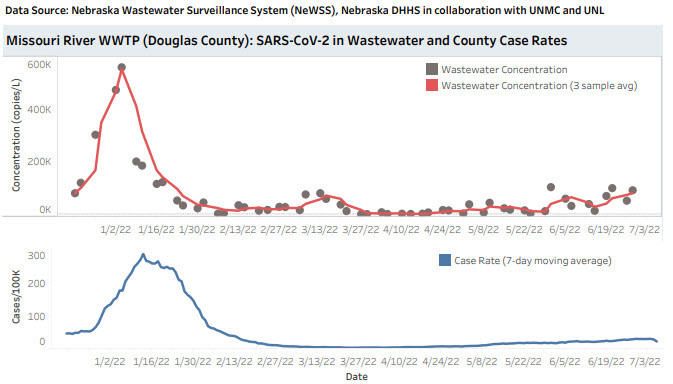How wastewater shows a COVID surge

Wastewater testing can provide an early warning of increasing COVID-19 cases in communities.
Likhitha Duggirala, BDS, MPH, explains how this new method helps public health experts track the virus's spread. As an epidemiology surveillance coordinator with Nebraska Department of Health and Human Services, Duggirala works directly on Nebraska's wastewater surveillance program.
Duggirala says there are four ways that wastewater testing helps public health experts:
- Monitor infections in the community. Wastewater surveillance doesn't depend on people having access to or getting COVID-19 tests.
- Track trends in the community – is COVID-19 increasing or decreasing overall?
- Alert public health experts to act quickly. If cases are on the rise, public health experts can recommend protections for their community.
- Screen a building or facility for COVID-19. For example, University of Nebraska Medical Center researchers used wastewater testing to detect new COVID-19 infections in Omaha Public Schools that wouldn't have been detected otherwise.
Why is COVID-19 in wastewater?
Believe it or not, your poop contains clues about your health. "People infected with SARS-CoV-2 can shed the virus in their feces, even if they don't have symptoms," explains Duggirala. Since everybody's waste goes to one place – the sewer – public health experts can collect samples and see how much COVID-19 is in the community.
It's important to note that people are not coming into contact with the wastewater and getting sick that way.
How does wastewater testing for COVID-19 work?
Teams from University of Nebraska Medical Center, University of Nebraska – Lincoln and Nebraska DHHS work together to collect, analyze and report the data.
- Sample collection: UNL researchers coordinate the logistics of sample collection. Researchers or facilities operators collect a sample at wastewater treatment plants, seal it and send it to the lab. They pull a new sample from the same location each week. There are 15 locations in Nebraska where samples are collected with plans to add more.
- Sample processing: UNMC College of Public Health lab receives and processes the samples. After preparing the sample, they extract the RNA (code unique to the virus) and measure the concentration of virus in wastewater.
- Data interpretation: Nebraska DHHS collects the data from wastewater treatment plants, UNL and UNMC College of Public Health and interprets it. They process the data before sending it on the Centers for Disease Control and Prevention.
- Data reporting: Nebraska DHHS publishes a weekly Wastewater Surveillance Report.
Everyone around the country uses a standardized process from the CDC for wastewater testing and processing.
How accurate is COVID-19 wastewater testing?
Wastewater testing is used as an additional method to track COVID-19 spread. However, it's currently difficult to predict exact COVID-19 community transmission levels based on wastewater testing alone.
So far, wastewater testing correlates (or moves up and down) with official case counts, which suggests wastewater surveillance is reliable.
Because everybody poops – and not everybody tests – wastewater testing can capture a more complete picture than case counts.
The official COVID-19 case counts undercount total cases because:
- At-home tests are not included in the official counts
- People with asymptomatic COVID-19 (no symptoms) are unlikely to seek testing
- Lack of testing accessibility remains an issue
- People don't always seek testing when they're sick, for several reasons
"In underserved communities, where testing and health care is less accessible, wastewater surveillance helps to assess COVID-19 disease burden in the community," says Duggirala.
For higher accuracy, public health experts don't compare levels of COVID-19 from one location with another location. They only compare one location's levels over time.
Will COVID-19 surge again?
Wastewater testing monitors COVID-19 spread, in addition to case counts and number of hospitalizations. But hospitalizations are a lagging indicator – by the time someone has been hospitalized, it's days or even weeks after they've been exposed to COVID-19. It takes time for people to be tested and then for the numbers to be reported.
In contrast, continuous wastewater testing for the community can be an early indicator of an increase in COVID-19 spread. "Wastewater surveillance can be a leading indicator by three to six days in advance," says Duggirala. "It's an alarm system. During the omicron surge, we saw virus levels in wastewater surveillance increase before the case rates went up."
Below is the most recent wastewater surveillance data for Douglas County. You can see an uptick in the top graph with the red line. That means COVID-19 cases are likely increasing in Douglas County.
Source: Nebraska DHHS Wastewater Surveillance Report.








